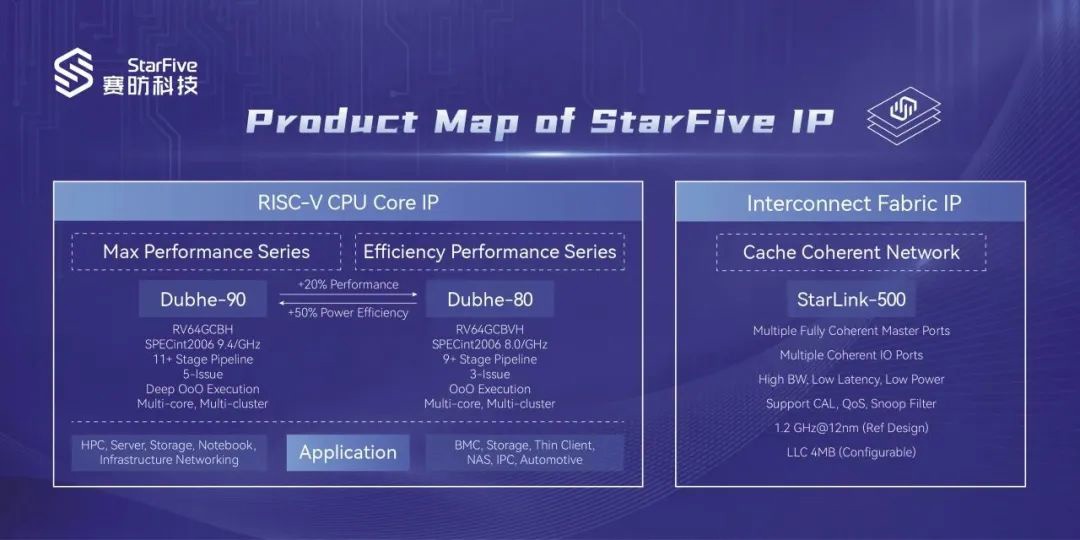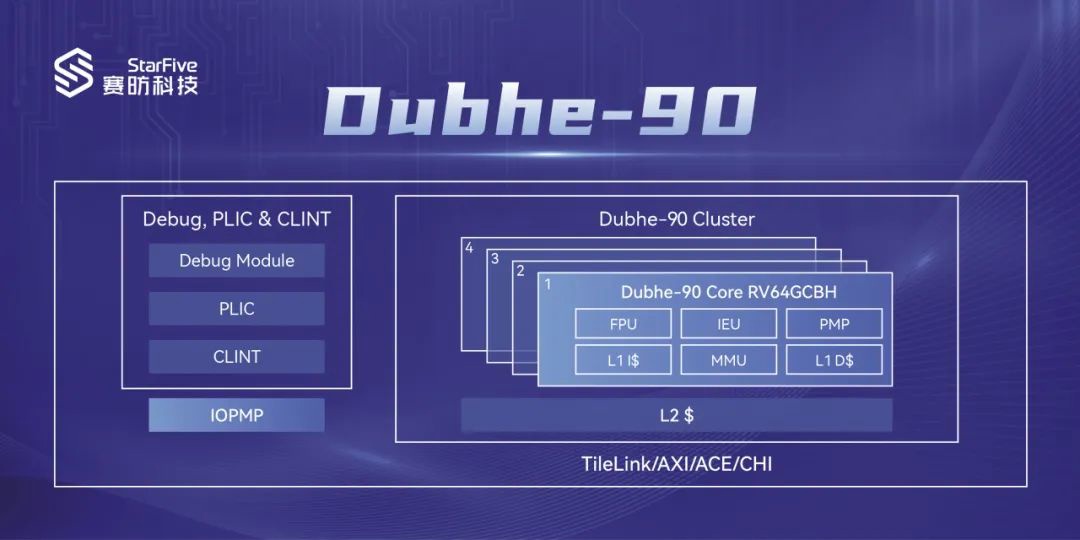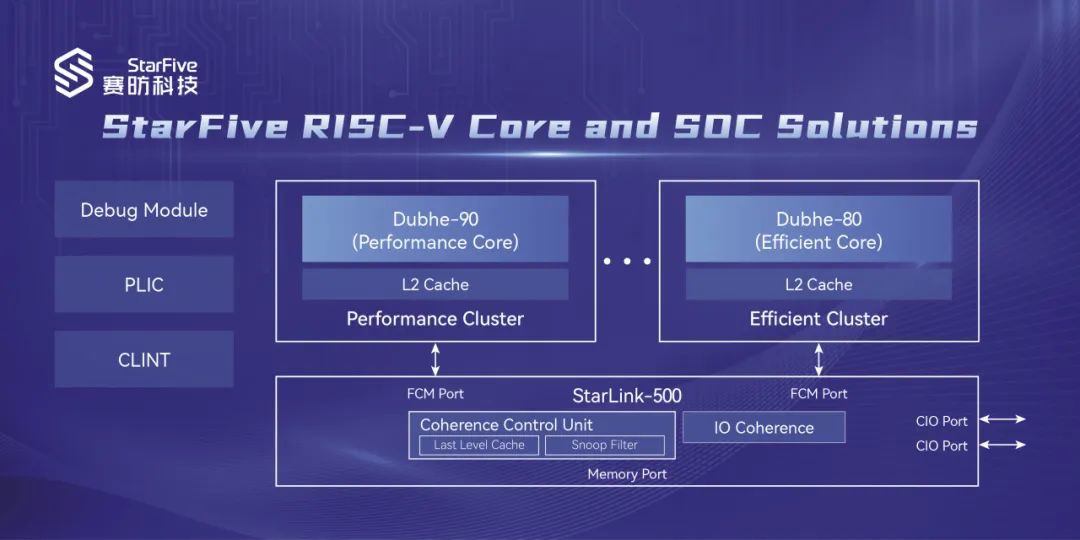 Technology peripherals
Technology peripherals
 It Industry
It Industry
 Saifang Technology releases the world's first RISC-V large and small core processor subsystem, with performance comparable to ARM A76 / A75
Saifang Technology releases the world's first RISC-V large and small core processor subsystem, with performance comparable to ARM A76 / A75
Saifang Technology releases the world's first RISC-V large and small core processor subsystem, with performance comparable to ARM A76 / A75
According to news from this site on August 17, Sai Fang Technology today released two new independently developed RISC-V processor core products: Fang Tianshu-90 (Dubhe-90) and Fang Tianshu -80(Dubhe-80).
According to the introduction, Dubhe-90 is the flagship product of Dubhe Max Performance series, focusing on providing ultimate performance; while Dubhe-80 is the first product of Dubhe Efficiency Performance series, focusing on high energy efficiency ratio. These two products are also widely known as the large and small cores of the CPU
At the same time, based on Dubhe-90, Dubhe-80 and Xifang Technology’s on-chip consistent interconnection IP - StarLink-500 (StarLink -500), Saifang Technology has released the first domestic high-performance RISC-V multi-core subsystem IP platform, claiming to be the world's first RISC-V large and small core processor subsystem solution, filling the gap between RISC- There is a gap in the corresponding market in the V field.

Sai Fang Technology name, 昉·天树-90 "big core" performance is comparable to ARM Cortex-A76, SPECint2006 9.4/GHz. Customers mainly come from high-end application fields such as PC, high-performance network communications, machine learning, and data centers.

Compared with 昉・天顺-90, 昉・天顺-90 The Hub-80 is claimed to have a 50% improvement in energy efficiency with a performance difference of only 20%, meeting the application needs of mobile, desktop, industrial control, artificial intelligence, automotive and other scenarios.
昉・天树-80 adopts a 9-stage pipeline, three-launch, out-of-order execution design, SPECint2006 8.0/GHz, claims to have performance exceeding ARM Cortex-A75, and supports the most complete RISC-V to date Instruction set , including RV64GC, bit operation extension B (Bitmanip 1.0), vector extension V (Vector 1.0) and virtualization extension H (Hypervisor 1.0), etc.

Based on Dubhe-90, Dubhe-80 and StarLink-500, Saifang Technology releases the first domestic high-performance RISC-V multi-core subsystem IP platform solution, supports the consistent collaborative work of 8 cores, and can be widely used in PCs, laptops, mobile devices, thin Main control chip design for clients, NAS, industrial computers and various industry terminals. A search on this site found that Sai Fang Technology's RISC-V processor - Fang Jinghong-8100 (JH-8100) adopts this design.

All articles on this site contain external jump links. In conveying more information and saving selection time, the results are for reference only
The above is the detailed content of Saifang Technology releases the world's first RISC-V large and small core processor subsystem, with performance comparable to ARM A76 / A75. For more information, please follow other related articles on the PHP Chinese website!

Hot AI Tools

Undresser.AI Undress
AI-powered app for creating realistic nude photos

AI Clothes Remover
Online AI tool for removing clothes from photos.

Undress AI Tool
Undress images for free

Clothoff.io
AI clothes remover

Video Face Swap
Swap faces in any video effortlessly with our completely free AI face swap tool!

Hot Article

Hot Tools

Notepad++7.3.1
Easy-to-use and free code editor

SublimeText3 Chinese version
Chinese version, very easy to use

Zend Studio 13.0.1
Powerful PHP integrated development environment

Dreamweaver CS6
Visual web development tools

SublimeText3 Mac version
God-level code editing software (SublimeText3)

Hot Topics
 1386
1386
 52
52
 How to adjust the large and small core scheduling in win11? Tips for optimizing performance win11
Jan 10, 2024 am 08:25 AM
How to adjust the large and small core scheduling in win11? Tips for optimizing performance win11
Jan 10, 2024 am 08:25 AM
Since Intel's 12th generation Core began to officially adopt large and small core designs, it has been criticized by many users. However, after upgrading to Win11, since Win11 has optimized the large and small core design, the performance difference is not very big. But once you run some large games or virtual machines, the problem of large and small core scheduling is amplified. So let’s see what to do next. The most basic method is to increase the priority of the process. Find the process whose priority you want to increase on the "Details" page of the Task Manager. Taking the vmware virtual machine as an example, right-click the vmware virtualization process vmware-vmx.exe, select "Set Priority", and select "
 The first RISC-V Android device will be commercialized on a large scale this year, and the Xuantie C930 flagship processor will be released within the year
Mar 14, 2024 pm 09:52 PM
The first RISC-V Android device will be commercialized on a large scale this year, and the Xuantie C930 flagship processor will be released within the year
Mar 14, 2024 pm 09:52 PM
According to news from this site on March 14, at the 2024 Xuantie RISC-V Ecological Conference held today, DAMO Academy announced the upgrade of a number of Xuantie processors: Xuantie C907 implemented matrix operation (Matrix) expansion for the first time. In the future, AI accelerated computing will provide more options and will be integrated into other Xuantie processors; the next generation flagship processor C930 will also be launched within the year. In addition, the first RISC-V-based Android device will also be commercialized on a large scale in 2024. At present, international and domestic mainstream operating systems have completed full adaptation to RISC-V, including Android, Linux, OpenHarmony, Debian, Fedora, Gentoo, Ubuntu, Dragon Lizard, Tongxin, op.
 Pingtouge Xuantie RISC-V processor C920, C907, R910 released, the first Android device will be launched next year
Nov 22, 2023 pm 06:38 PM
Pingtouge Xuantie RISC-V processor C920, C907, R910 released, the first Android device will be launched next year
Nov 22, 2023 pm 06:38 PM
According to news from this site on November 22, on November 21, Pingtou Ge Xuantie RISC-V launched three new processors: C907 that realizes AI matrix expansion for the first time, C920 that meets the Vector1.0 standard, and real-time processor R910. It claims to accelerate the large-scale commercial implementation of RISC-V in scenarios and fields such as autonomous driving, artificial intelligence, enterprise-level SSD, and network communications. According to reports, based on software and hardware collaborative optimization, the C920 has been upgraded to support the latest Vector1.0 standard, which can achieve more accurate and stable task allocation, allowing each thread to maximize performance, thereby improving overall performance. C920 has improved AI performance by up to 3.8 times compared to the previous generation, and can run Transformer models, making it suitable for machine learning.
 The world's first RISC-V laptop upgrades to the second generation, DC-ROMA RISC-V Laptop II will be pre-installed with Ubuntu system
Jun 14, 2024 am 09:39 AM
The world's first RISC-V laptop upgrades to the second generation, DC-ROMA RISC-V Laptop II will be pre-installed with Ubuntu system
Jun 14, 2024 am 09:39 AM
This site reported on June 13 that DC-ROMA is the world's first native RISC-V development laptop led by the RISC-V Foundation, developed by Deep Digital Intelligence and debugged by Jianshi Technology. It was released in March last year. ▲DC-ROMARISC-VLaptopII After more than a year, Deepin Digital announced the launch of DC-ROMARISC-VLaptopII notebook, which is the second generation of the product. This machine is also the world’s first RISC-V laptop with Ubuntu pre-installed. The new DC-ROMARISC-VLaptopII is equipped with the "SpacemiTKeyStoneK1" 8-core RISC-VCPU for the first time, running at a maximum speed of 2.0GHz
 What is the difference between riscv architecture and arm
Aug 22, 2023 pm 01:47 PM
What is the difference between riscv architecture and arm
Aug 22, 2023 pm 01:47 PM
The difference between riscv architecture and arm: 1. Design philosophy. The riscv design philosophy is to simplify the instruction set and improve instruction execution efficiency. The arm design philosophy is to add some special instructions and registers while maintaining the simplicity of the instruction set to improve specific application scenarios. Performance; 2. Openness, riscv instruction set architecture specifications are publicly available and free to use, arm has some restrictions on the definition and use of its instruction set architecture; 3. Application fields, riscv is used in embedded systems, mobile devices, high-performance computing, etc. , arm is used in mobile devices and embedded systems.
 Saifang Technology releases the world's first RISC-V large and small core processor subsystem, with performance comparable to ARM A76 / A75
Aug 20, 2023 pm 03:37 PM
Saifang Technology releases the world's first RISC-V large and small core processor subsystem, with performance comparable to ARM A76 / A75
Aug 20, 2023 pm 03:37 PM
According to news from this site on August 17, Sai Fang Technology today released two new self-developed RISC-V processor core products: Fang Tianshu-90 (Dubhe-90) and Fang Tianshu-80 (Dubhe-80 ). According to the introduction, Dubhe-90 is the flagship product of the Dubhe Max Performance series, focusing on providing ultimate performance; while Dubhe-80 is the first product of the Dubhe Efficiency Performance series, focusing on high energy efficiency. These two products are also widely known as the large and small cores of the CPU. At the same time, they are based on Dubhe-90, Dubhe-80 and Safang Technology's on-chip consistent interconnection IP - Fang Starlink-500 (Sta
 It can transform notebooks into RISC-V architecture. Framework and Deepin Digital launch customized modular motherboards
Jun 19, 2024 pm 12:31 PM
It can transform notebooks into RISC-V architecture. Framework and Deepin Digital launch customized modular motherboards
Jun 19, 2024 pm 12:31 PM
According to news from this website on June 19, modular notebook company Framework announced that it will support RISC-V architecture. Currently, the company has cooperated with Deepin Digital Intelligence to customize a "DC-ROMARISC-V modular mini motherboard" for its FrameworkLaptop13. The motherboard is equipped with a quad-core 1.5GHz RISC-VStarFiveJH7110SoC, which is mainly used for development purposes. ▲FrameworkLaptop13 notebook computer Although this motherboard is very eye-catching, its performance and scalability have not yet been able to compete with the Intel/AMD-driven FrameLaptop notebook computer. Our philosophy is very clear. This motherboard is mainly suitable for developers.
 Imagination teams up with Ventana to demonstrate heterogeneous CPU-GPU SoC simulation results
Nov 06, 2023 am 09:25 AM
Imagination teams up with Ventana to demonstrate heterogeneous CPU-GPU SoC simulation results
Nov 06, 2023 am 09:25 AM
According to news from this website on November 6, high-performance RISC-VCPU design company Ventana and Imagination jointly developed the heterogeneous CPU-GPUSoC. The two companies will display their simulation models at the RISC-V Summit next week. According to reports, both companies are major members of the RISC-V International and RISC-V Software Ecosystem (RISE) projects, and are both firm advocates of open architecture. VentanaMicroSystems was founded in 2018, and its first product is VeyronV1, launched at the RISC-V Summit in December 2022. Ventana will launch VeyronV2 next week.



